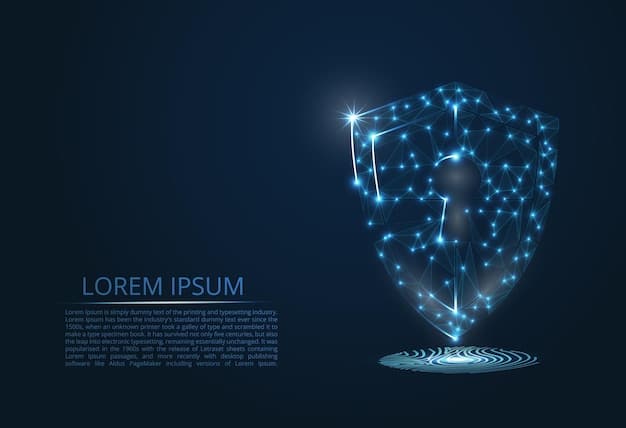New Cybersecurity Threat Targets Banking Apps: Protect Accounts Now

A new sophisticated cybersecurity threat has been identified, specifically targeting banking applications, urging immediate action from users to protect their financial accounts against potential breaches and fraud.
A critical new cybersecurity threat has emerged, specifically designed to compromise popular banking applications. This sophisticated attack vector requires immediate awareness and protective measures from all users to safeguard their financial information and prevent unauthorized access. Understanding this evolving landscape is key to maintaining digital financial security.
understanding the new cybersecurity threat
In the evolving digital landscape, a new formidable cybersecurity threat has surfaced, meticulously designed to infiltrate and exploit vulnerabilities within mobile banking applications. This isn’t merely another phishing attempt or a generic malware; it represents a specialized, targeted assault crafted with a deep understanding of app security protocols and user behaviors. Threat intelligence reports indicate that this particular strain of cyberattack focuses on bypassing multi-factor authentication (MFA) mechanisms and exploiting latent weaknesses in app-to-server communications, making it particularly dangerous.
Unlike broad-spectrum attacks that cast a wide net, this new threat is characterized by its precision. Cybercriminals are employing advanced persistent threat (APT) tactics, meaning they are investing significant time and resources into researching specific banking app architectures and user habits. Their goal is not just to gain access, but to maintain a persistent foothold, often unnoticed, to siphon financial data over extended periods. This requires a level of sophistication previously uncommon in consumer-facing cyber threats.
how the attack works
The core mechanism revolves around a combination of social engineering and technical exploitation. Users might receive seemingly legitimate messages or links, often disguised as official bank communications or software updates. Once clicked, these links don’t necessarily install a visible app. Instead, they might leverage zero-day exploits in operating systems or inject malicious code directly into legitimate banking apps, or even create highly convincing overlay screens to trick users into divulging credentials.
The malicious code then operates clandestinely, intercepting inputs, logging keystrokes, or even mirroring screens to capture sensitive information like usernames, passwords, and one-time passwords (OTPs). What makes this particularly insidious is its ability to bypass certain biometric authentication methods if the initial access is gained through device compromise. This means a direct compromise of the device itself can render even advanced security features ineffective.
- 🕵️♂️ Phishing Redefined: Attackers use highly customized and believable phishing techniques tailored to individual banking app users.
- 🔗 Exploit Chains: The threat leverages a series of vulnerabilities, often combining software flaws with social engineering.
- 👻 Stealth Operations: Malicious activity remains hidden, operating in the background without overt signs of compromise.
- 🔑 Credential Harvesting: Focus is on capturing login details, including elusive multi-factor authentication codes.
Moreover, the threat actors behind these attacks are increasingly leveraging artificial intelligence and machine learning to refine their phishing campaigns, making them more adaptive and harder to detect by traditional security filters. This allows them to craft messages that resonate more effectively with individual targets, increasing their success rate. The rapid evolution of these tactics signals a new frontier in financial cybercrime, demanding a proactive and informed response from both banks and their customers. Protecting against this new threat requires a multi-layered approach, ranging from robust endpoint security to enhanced user awareness.
identifying the signs of compromise
Recognizing the indicators of a compromised banking app or device is paramount for timely intervention and damage control. While this new threat prioritizes stealth, certain anomalies can betray its presence. Vigilance and a keen eye for unusual digital behavior are your first lines of defense. It’s crucial to differentiate between normal app behavior and potential signs of intrusion, which often manifest as subtle shifts rather than overt warnings. The hallmark of a sophisticated attack is its ability to remain undetected; thus, attention to detail becomes critical for users.
One primary indicator might be unusual transaction activity on your bank statements that you do not recognize. This is often the most alarming sign and requires immediate investigation. However, precede this are often more subtle digital cues. Your device might experience unexpected performance issues, such as a significant slowdown, rapid battery drain, or applications crashing more frequently than usual. These can be symptoms of malicious software running covertly in the background, consuming system resources. The malicious payload might also attempt to communicate with external servers, leading to unusual network activity.
unusual app behavior and device anomalies
Beyond transactional discrepancies, observe the behavior of your banking app itself. Does it take longer to load? Are there unfamiliar screens or prompts appearing? Has the app’s interface subtly changed? Attackers sometimes deploy overlay attacks, where a fake login screen appears over the genuine app, capturing your credentials. Be wary of any requests for unusual permissions from your banking app or other apps that seem out of place. For instance, if a legitimate banking app suddenly requests access to your microphone or contacts, it should raise a red flag.
- 📲 Unexpected App Behavior: App loads slowly, crashes, or displays unusual pop-ups/screens.
- ⚡ Rapid Battery Drain: Malicious processes consume significant device power discreetly.
- 🌐 Increased Data Usage: Unexplained spikes in mobile data consumption could indicate data exfiltration.
- ⚙️ Device Performance Issues: General slowdowns, freezing, or difficulty in running other applications.
- 💬 Suspicious Messages: Receiving unexpected SMS or push notifications that claim to be from your bank, asking for sensitive information.
Furthermore, pay close attention to your communication channels. Be suspicious of unsolicited SMS messages, emails, or calls claiming to be from your bank, especially if they contain links, request personal information, or insist on urgent actions. These social engineering tactics are often the initial vector for sophisticated cyberattacks. A bank will typically never ask for your full password, PIN, or OTP via unsolicited communication. If you suspect any of these signs, disconnect your device from the internet immediately to prevent further data leakage and contact your bank through official channels.
proactive steps to secure your banking apps
Securing your banking applications in the face of evolving cyber threats demands a proactive and multi-faceted approach. Relying solely on your bank’s security measures is insufficient; individual user responsibility plays a crucial role. Implementing a layered defense strategy can significantly reduce your exposure to sophisticated attacks and protect your financial well-being. This isn’t about paranoia, but rather about cultivating a robust digital hygiene that parallels your physical security awareness. Adopting these practices now can save you significant trouble in the future.
Firstly, ensure all your banking applications and your device’s operating system are consistently updated to their latest versions. Software updates frequently include critical security patches that address newly discovered vulnerabilities. Running outdated software is akin to leaving your front door unlocked. Enable automatic updates whenever possible, or make it a routine to check for and install them. Developers are constantly patching flaws, and delaying these updates leaves you exposed to known exploits. This is a foundational step in cybersecurity.
essential security practices
Beyond updates, strong, unique passwords are non-negotiable. Avoid using easily guessable information or reusing passwords across multiple accounts. Consider using a reputable password manager to generate and store complex, unique passwords for each of your online banking accounts. This mitigates the risk associated with a data breach on one service compromising your other accounts. Furthermore, whenever available, enable multi-factor authentication (MFA) – preferably using authenticator apps or hardware tokens over SMS-based OTPs, as SMS can be vulnerable to SIM swap attacks. MFA adds an extra layer of security, making it exponentially harder for unauthorized users to access your accounts even if they possess your password.
- 🔒 Enable MFA: Always use multi-factor authentication, preferably app-based.
- 🔄 Regular Updates: Keep all banking apps and device OS updated to the latest versions.
- 🚫 Public Wi-Fi Beware: Avoid accessing banking apps on unsecured public Wi-Fi networks.
- 💪 Strong Passwords: Use unique, complex passwords for each banking app, ideally with a password manager.
- 📱 Device Security: Implement strong device passcodes, biometrics, and avoid jailbreaking/rooting your device.
Lastly, be extremely cautious about what you click on and what information you share online. Phishing attempts are becoming increasingly sophisticated, mimicking legitimate communications. Always verify the sender’s authenticity by independently navigating to the official bank website or calling their official customer service number. Never click on suspicious links in emails or text messages, and never provide personal or financial information in response to unsolicited requests. Educating yourself about common social engineering tactics can be as effective as any technical security measure.

the role of banks in protecting your accounts
While individual user vigilance is crucial, the primary responsibility for securing banking applications also heavily rests on the financial institutions themselves. Banks invest colossal resources into cybersecurity, operating sophisticated defense systems designed to detect, prevent, and respond to threats. Their role extends far beyond merely providing an app; it encompasses the entire ecosystem of digital trust and financial security, serving as the first line of enterprise-level defense against cybercriminals. Understanding their commitment helps to contextualize the shared responsibility of cybersecurity.
At the foundational level, banks employ robust encryption technologies for data in transit and at rest, ensuring that customer information is inaccessible to unauthorized parties. They also implement state-of-the-art intrusion detection and prevention systems (IDPS) that continuously monitor network traffic for suspicious patterns indicative of an attack. These systems are often powered by artificial intelligence and machine learning, allowing them to adapt to new and emerging threats in real-time. Regular security audits and penetration testing by independent third parties are also standard practice, meticulously probing for vulnerabilities before malicious actors can exploit them.
bank security measures and user support
Beyond technical safeguards, banks are increasingly focusing on user education and proactive communication. They often publish security advisories, offer tips on safe online practices, and provide clear channels for reporting suspicious activity. Many banks have dedicated fraud detection teams that monitor transactions for unusual patterns, often flagging and blocking suspicious activities before the customer is even aware. This proactive fraud monitoring, coupled with a responsive customer support system for dispute resolution, forms a critical safety net for users.
- 🛡️ Robust Encryption: Protecting data during transmission and storage.
- 🚨 Fraud Monitoring: AI-powered systems detect and flag suspicious transactions in real-time.
- ☎️ Dedicated Support: Easy access to customer service for reporting anomalies or fraud.
- 📈 Regular Audits: Continuous security checks and penetration testing of their systems.
- 🧑🏫 User Education: Providing resources and alerts to help customers stay secure.
Furthermore, banks are actively collaborating with cybersecurity firms, government agencies, and industry bodies to share threat intelligence and develop collective defense strategies against sophisticated cybercriminal groups. This collaborative approach ensures that the industry as a whole is better prepared to tackle global cyber threats. While banks provide a formidable shield, the partnership with informed and vigilant customers creates the strongest defense. It’s a symbiotic relationship where both parties play an indispensable role in safeguarding financial assets against the ever-present dangers of the digital world.
reporting and recovering from a breach
Despite best efforts, a cybersecurity breach involving your banking apps can unfortunately occur. Knowing the immediate steps to take, whom to contact, and how to begin the recovery process is critical. Swift action can significantly mitigate potential financial losses and help secure your accounts from further damage. Panicking is counterproductive; a methodical and informed response is essential. Prepare yourself mentally for the possibility, just as you would for any other unexpected emergency.
The very first action upon suspecting or confirming a breach is to immediately contact your bank through their official fraud department or customer service hotline. Do not use any contact information found in a suspicious email or text message; always refer to the numbers listed on your official bank statements, bank card, or their verified website. Informing them promptly allows them to freeze compromised accounts, reverse fraudulent transactions, and take other necessary security measures to prevent further unauthorized activity. Time is of the essence in these situations.
steps for effective recovery
Once your bank has been notified, change passwords for all your online banking accounts, and for any other linked financial services (e.g., payment apps, investment platforms). If you have reused passwords, change them for every account where that password was used. Simultaneously, it’s advisable to run a comprehensive antivirus and anti-malware scan on your smartphone or device that hosts the banking apps. Consider performing a factory reset if the device is severely compromised and your data is backed up, but consult with an IT expert first.
- 📞 Contact Bank Immediately: Call your bank’s official fraud department.
- 🔑 Change Passwords: Update all affected and linked account passwords.
- 📊 Monitor Statements: Scrutinize bank and credit card statements for suspicious transactions.
- 🛡️ Device Scan: Run thorough antivirus/anti-malware scans on your device.
- 👮♂️ Report to Authorities: File a report with relevant law enforcement or cybercrime agencies.
Beyond securing your accounts and devices, it’s prudent to monitor your credit reports for any suspicious activity, such as new accounts opened in your name. You are entitled to a free credit report from each of the three major credit bureaus (Equifax, Experian, and TransUnion) annually. Consider placing a fraud alert or a credit freeze on your credit files. Finally, report the incident to relevant law enforcement agencies, such as the FBI’s Internet Crime Complaint Center (IC3) in the U.S., as this helps in tracking cybercriminal activities and might aid in broader investigations. Document all communications and actions taken, as this can be vital for legal or insurance purposes.
the future of banking app security
The landscape of cybersecurity is in a constant state of flux, driven by technological advancements and the escalating sophistication of cybercriminals. As banking applications become increasingly central to our financial lives, their security measures are also evolving, pushing towards more resilient and user-friendly protection mechanisms. The future of banking app security will likely be characterized by a blend of cutting-edge technology and a personalized approach to risk management, moving beyond traditional static defenses to dynamic, adaptive systems. This ongoing arms race demands continuous innovation from financial institutions.
One significant trend expected to gain prominence is the wider adoption of behavioral biometrics. Instead of relying solely on fingerprint or facial recognition, behavioral biometrics analyze unique user patterns such as typing rhythm, swipe gestures, and even the way a user holds their phone. This creates a highly personalized and continuously verifying authentication layer that is extremely difficult for fraudsters to mimic. This type of passive authentication works unobtrusively in the background, enhancing security without inconveniencing the user, representing a significant leap from current authentication methods.
emerging security technologies
Another area of rapid development is the application of advanced artificial intelligence and machine learning (AI/ML) for predictive threat intelligence. Current AI systems are already good at detecting known attack patterns, but future systems will be capable of predicting novel attack vectors before they fully materialize, based on vast datasets of global cyber activities. This proactive approach will enable banks to fortify their defenses against zero-day exploits more effectively. Quantum-resistant cryptography is also on the horizon, preparing the financial sector for a future where current encryption standards might be vulnerable to powerful quantum computers.
- 🧠 AI/ML for Prediction: Anticipating threats before they occur using advanced algorithms.
- 👁️ Behavioral Biometrics: Continuous, passive authentication based on unique user habits.
- 🔐 Quantum-Resistant Crypto: Preparing for the future of unbreakable encryption.
- ⛓️ Blockchain for Integrity: Exploring distributed ledger technology for enhanced transaction security.
- 🧩 Zero Trust Architecture: Implementing models that verify every access request, regardless of origin.
Furthermore, the concept of ‘Zero Trust’ architecture will become more prevalent. Instead of assuming trust based on network location, every user and device trying to access resources will be rigorously authenticated, authorized, and continuously validated. This model significantly reduces the attack surface and minimizes the impact of a breach if one occurs. The future of banking app security is not just about preventing attacks, but also about building inherently resilient systems that can withstand and quickly recover from even the most sophisticated cyber assaults, ensuring uninterrupted and secure financial services for all users.

best practices for individual digital hygiene
While banks are constantly enhancing their security frameworks, individual digital hygiene remains the cornerstone of personal cybersecurity. The most sophisticated security systems can be undermined by simple user errors or negligence. Therefore, adopting a diligent and consistent set of personal best practices is as vital as the technological safeguards themselves. This proactive approach isn’t just about protecting your banking apps; it’s about fortifying your entire digital footprint against a myriad of online threats. Think of it as building healthy habits for your digital self, just as you would for your physical health.
A fundamental practice is to maintain separate and strong passwords for distinct online services. Reusing passwords is one of the most common vulnerabilities; if one service is breached, all other accounts sharing that password become susceptible. Utilize a reputable password manager to generate and securely store unique, complex passwords. These tools not only simplify password management but also eliminate the need to remember dozens of intricate combinations, thereby encouraging stronger password practices. Setting up multi-factor authentication (MFA) everywhere it’s available, especially for email and financial accounts, adds a crucial second layer of defense. Prioritize authenticator apps over SMS-based MFA for enhanced security against SIM swap attacks.
cultivating a secure digital mindset
Beyond passwords, exercise extreme caution when interacting with emails, text messages, and links from unknown or suspicious sources. Phishing and social engineering remain primary vectors for cyberattacks. Always verify the authenticity of a sender, especially if the message requests personal information, urges immediate action, or contains unexpected attachments or links. When in doubt, navigate directly to the official website or contact the organization through verified phone numbers, rather than clicking on embedded links. Regularly back up your important data to external drives or secure cloud services. This ensures that even in the event of a ransomware attack or data loss, your critical information remains safe and recoverable.
- 🔒 Unique Passwords: Use a password manager for distinct, strong credentials.
- 👀 Verify Senders: Always confirm legitimacy of emails/texts; avoid suspicious links.
- ☁️ Data Backup: Regularly back up important files to external drives or secure cloud.
- 🧹 Software Updates: Keep all software, apps, and operating systems up-to-date.
- 🚫 Public Wi-Fi caution: Avoid sensitive transactions on unsecured public networks.
Finally, be mindful of your online presence and the information you share publicly, particularly on social media. Cybercriminals often use publicly available information to craft targeted social engineering attacks. Keeping your operating systems, applications, and antivirus software updated is non-negotiable, as updates often include critical security patches. Regularly review your privacy settings on all platforms and limit the personal information that is visible to the public. By consistently practicing these digital hygiene habits, you bolster your personal cybersecurity posture, creating a more resilient barrier against the evolving landscape of cyber threats.
| Key Action | Brief Description |
|---|---|
| 🔄 Update Apps & OS | Ensure all banking apps and device software are current for security patches. |
| 🔑 Enable MFA | Activate multi-factor authentication for an extra security layer. |
| 🚫 Vigilant on Links | Never click suspicious links in emails or texts claiming to be your bank. |
| 📞 Report Immediately | Contact your bank quickly if you suspect any unauthorized activity. |
frequently asked questions
▼
This new threat is a highly sophisticated, targeted cyberattack specifically designed to compromise mobile banking applications. It leverages advanced social engineering tactics and technical exploits to bypass security measures, including multi-factor authentication, with the goal of gaining unauthorized access to user accounts and financial data. Its stealth and precision make it particularly dangerous compared to generic malware.
▼
Look for unusual activity like unexpected transactions, rapid battery drain on your device, increased data usage, or a significant slowdown in device performance. Other signs include the banking app behaving erratically, displaying unusual screens, or requesting strange permissions. Always be suspicious of unsolicited messages asking for personal banking details or containing suspicious links. Trust your intuition if something feels off.
▼
Firstly, ensure your banking app and device’s operating system are fully updated. Enable multi-factor authentication (MFA) on all banking and email accounts, preferring authenticator apps over SMS. Use strong, unique passwords for each account, ideally with a password manager. Be extremely cautious of phishing attempts; never click suspicious links from unknown senders. Always access your banking via the official app or website.
▼
Banks are constantly investing in advanced cybersecurity measures, including robust encryption, AI-powered fraud detection systems, and regular security audits. They also provide customer support for reporting fraud and offer educational resources to help users stay safe. Many banks actively collaborate with cybersecurity firms and law enforcement to share threat intelligence and collectively fight cybercrime, building a strong defensive posture.
▼
Immediately contact your bank’s official fraud department using their verified contact numbers (from bank statements or official website, not suspicious emails). Change all affected passwords and any reused passwords on other accounts. Scan your device for malware. Monitor your credit reports for suspicious activity and consider placing a fraud alert. Report the incident to relevant cybersecurity authorities like the FBI’s IC3 in the U.S.
conclusion
The emergence of a new, highly sophisticated cybersecurity threat targeting banking applications serves as a potent reminder of the ever-present dangers in our increasingly digital financial lives. Protecting your accounts is a shared responsibility, demanding continuous vigilance from individuals and relentless innovation from financial institutions. By staying informed about evolving threats, meticulously adhering to best practices like regular software updates and robust multi-factor authentication, and maintaining a healthy skepticism towards unsolicited communications, users can significantly harden their defenses. Banks, in turn, must continue their tireless work in developing advanced security protocols and leveraging cutting-edge technologies to safeguard customer assets. The synergy between informed users and proactive financial institutions forms the strongest bulwark against the cunning tactics of cybercriminals, ensuring a more secure and trustworthy digital banking experience for everyone.





